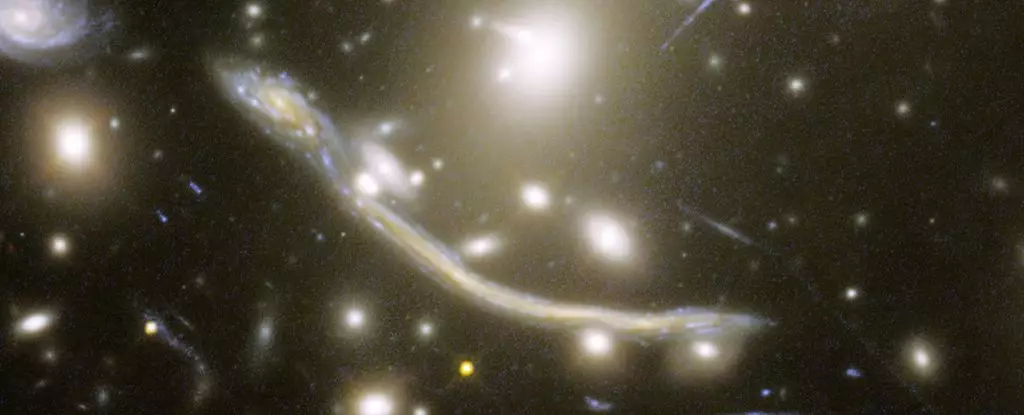As we gaze into the cosmos, we are confronted with a profound truth: the universe is both vast and intricate, filled with mysteries that have long evaded our comprehension. Traditional telescopes, despite their advanced technology, have struggled to penetrate the dense veil of space and time that separates us from early celestial phenomena. However, the advent of the James Webb Space Telescope (JWST) marks a transformative era in astronomical research, enabling scientists to observe the obscured wonders of the universe with unprecedented clarity. This revolutionary instrument has successfully resolved more than 40 individual stars on the periphery of a distant galaxy, whose light has taken an astonishing 6.5 billion years to reach Earth.
The significance of this discovery cannot be understated. According to astrophysicist Fengwu Sun from the University of Arizona, this observation exemplifies a monumental leap in our ability to study the cosmos. “While the Hubble Space Telescope previously identified only about seven stars in similar explorations, JWST has dramatically expanded our repertoire, allowing the observation of numerous individual stars that were once thought to be far beyond our reach,” he explains. This advancement not only deepens our understanding of stellar population dynamics in distant galaxies but also provides crucial insights into the enigmatic nature of dark matter and its influence on galaxy formation and behavior.
The JWST’s capabilities are further enhanced by the principles of general relativity, which describes how massive objects warp the fabric of space-time. Gravitational lensing, a phenomenon where the light from distant objects is distorted and magnified by the gravitational pull of intervening masses, allows astronomers to observe celestial wonders that would otherwise remain hidden. The Dragon Arc—an ethereal line of light that appears to twist across the night sky—serves as a perfect illustration of this effect. Created by the gravitational influence of the massive galaxy cluster Abell 370, located around 4 billion light-years away, the Dragon Arc allows scientists to glimpse the intricate details of galaxies that have evolved for billions of years in the cosmic dark.
While gravitational lensing has enabled the observation of larger structures, the JWST’s analysis also capitalizes on microlensing—an effect caused by smaller, individual stars that can distort light on a much finer scale. Researchers led by Yoshinobu Fudamoto of Chiba University recently took advantage of this phenomenon to resolve an astonishing 44 individual stars within the smudged radiance of the Dragon Arc. This discovery was serendipitous, as Fudamoto’s team initially aimed to identify a background galaxy being magnified by the gravitational lensing of the Abell 370 cluster. However, upon meticulous data processing, they uncovered numerous individual star points, an exciting development in our exploration of the distant universe.
Among the stars identified in the Dragon Arc, a substantial number are classified as red supergiants—massive stars nearing the end of their life cycle and exhibiting a cooler, redder hue. This revelation illuminates our understanding of stellar evolution across cosmic time scales, as these cooler, dimmer stars are more challenging to detect than their hotter, more luminous counterparts typically observed in distant galaxies. The JWST’s ability to analyze red light grants astronomers access to these elusive celestial bodies, thus enriching our comprehension of the composition and evolution of galaxies far beyond our own.
As researchers continue to refine their observational techniques and improve data processing methods, the JWST’s future missions are poised to unveil even more hidden stars within the Dragon Arc’s blurred fabric. The ongoing study of these distant celestial objects not only enhances our understanding of individual stellar phenomena but also contributes to the broader narrative of cosmic evolution—one that encompasses everything from the intricate formation of galaxies to the fundamental nature of the universe itself.
As we stand on the brink of this new frontier in astronomical exploration, the JWST heralds an exciting phase of discovery that promises to reshape our perceptions of the universe. The detailed observations of individual stars located billions of light-years away equip us with valuable knowledge about the nature of stellar populations, the formation of galaxies, and the role of dark matter within these expansive systems. The implications of these observations extend far beyond the confines of our planet; they provide a compelling glimpse into the universal processes that govern celestial bodies across the cosmos.
The James Webb Space Telescope is not merely a feat of engineering; it is a revolutionary tool that expands the boundaries of our cosmic understanding. As we continue to explore the secrets held within the fabric of space and time, JWST undoubtedly stands at the forefront, illuminating the dark recesses of the universe and unveiling the wonders hidden within.


Leave a Reply